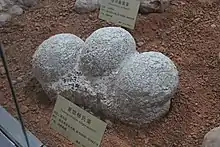Youngoolithus
Youngoolithus is an oogenus of dinosaur egg.[1] It is the sole member of the oofamily Youngoolithidae, and consists of a single oospecies: Youngoolithus xiaguanensis. It consists of a single fossil nest of 16 eggs with an associated dinosaur footprint that was first discovered in 1975 in the Majiacun Formation near Houzhuang Village, Henan Province, in the Cretaceous Xiaguan Basin. The eggs are smooth, olive-shaped, and arranged in five rows. It was originally described as being a Faveoloolithid egg, however the nest is arranged quite differently than other members of that family, so it has been moved to its own oofamily, Youngoolithidae.[2][3]
| Youngoolithus | |
|---|---|
 | |
| Eggs in Henan Geological Museum | |
| Egg fossil classification | |
| Basic shell type: | †Dinosauroid-spherulitic |
| Oofamily: | †Youngoolithidae Zhang, 2010 |
| Oogenus: | †Youngoolithus Zhao, 1979 |
| Oospecies | |
| |
References
- Carpenter, K. 1999. Eggs, Nests, and Baby Dinosaurs: A Look at Dinosaur Reproduction (Life of the Past). Indiana University Press, Bloomington, Indiana.
- Zhang, S. K. (2010). "A parataxonomic revision of the Cretaceous faveoloolithid eggs of China" (PDF). Vertebrata PalAsiatica. 48 (3): 203–219. Retrieved 3 October 2015.
- Zhao, Z. (1979). "Discovery of the dinosaurian eggs and footprint from Neixiang county, Henan province" (PDF). Vertebrata PalAsiatica. 17 (4): 304–309. Retrieved 3 October 2015.
This article is issued from Wikipedia. The text is licensed under Creative Commons - Attribution - Sharealike. Additional terms may apply for the media files.